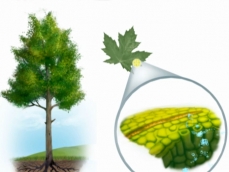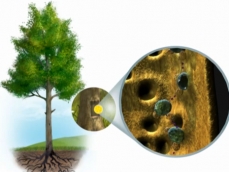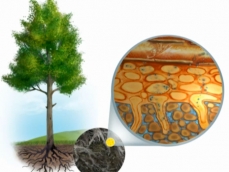Transcription of video clip Trees and water
Trees: living pumps

© Jardin botanique de Montréal
Transpiration of the tree's leaves
Trees draw water from the soil upwards. Their foliage is the main motor driving this movement.
During photosynthesis, leaves open their stomata and allow water to evaporate into the air.
This transpiration creates suction, which extends to the xylem in the leaf veins.
From one cell to its neighbour, then across the xylem, suction draws the water.

© Jardin botanique de Montréal
Water molecules in the xylem
The water molecules are loosely connected to each other. Like a series of magnets, pulling on one causes the others to follow.
The water molecules also link up to the xylem walls. This is called adherence.
In a glass, the water level is higher along the edge: that's adherence.

© Jardin botanique de Montréal
Root hairs absorb water from the soil.
The sucking effect extends all the way to the root hairs, which absorb water from the soil and direct it to the xylem.
This is how root hairs collect water from the soil.
The water molecules hold together by cohesion and to the xylem walls by adherence.
But in reality, the real motor of this hydraulic pump is in the leaves and their transpiration during photosynthesis.
Back to video clip




